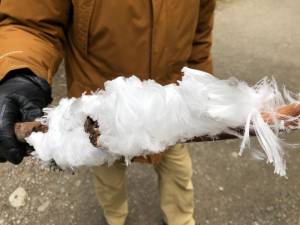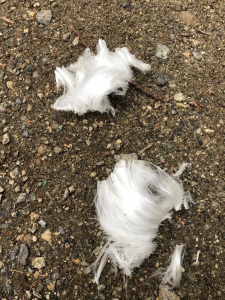
Feather Frost or Frost Flowers (Crystallofolia)
– By Douw Steyn, Department of Earth, Ocean and Atmospheric Sciences, University of British Columbia, Vancouver, BC. –
The attached photographs show an instance of the rare phenomenon of feather frost on a stick. There were instances of this kind of frost all over the forest floor, but only on sticks, logs and stumps, and apparently none on still-living plants.

I found the frost at 0900 PST on February 9th, 2021 on the forest floor around Fisherman’s Trail near the base of Capilano Canyon in North Vancouver at about 75 m ASL. The canyon floor around the trail is in a second-growth mixed coniferous forest (mainly Western Red Cedar, Douglas Fir and Western Hemlock). The temperature on the trail was slightly below freezing. Weather data from the nearby Vancouver International Airport (at 4 m ASL) shows a mostly clear preceding night with temperatures dipping to -8 C, and relative humidity of 55%, indicative of advancing modified arctic air.
Conventional interpretations are that this kind of frost arises from the sap being extruded by swelling near freezing through cracks in the plant. Thus producing sheets of fragile frost which grow through freezing at their base. On that morning, all observed instances of feather frost were on dead plants, mostly twigs and small branches and in some instances, dead but standing stumps. As can be seen from the photographs, the frost was formed in filaments, rather than sheets.

My interpretation is that this particular instance of feather frost was a result of moisture forming the filaments coming from whatever water was in the first few mm of wood, and not from sap. The frost occurred on dead sticks that were generally damp from the previous week’s rain. The example shown in Figure 1 was a clearly dead stick found lying on the forest floor. The filaments thus grow outwards from the bottom, unlike other forms of frost that grow from atmospheric moisture and accrete on the tips of dendritic crystals. The relatively low humidity and absence of wind mitigated against frost forming at the ice/air interface.
The frost filaments were extremely fragile. A gentle shake of the stick resulted in clumps filaments dislodging (shown in Figure 2), and drifting lightly to the ground, much like feathers. For this reason, I rather like the term, Feather Frost.
Regular frost needs: sub-zero temperatures; high atmospheric moisture, cooling (to remove latent heat of freezing); light wind to bring in more moisture.
Feather frost needs: sub-zero temperatures; low atmospheric moisture, cooling (to remove latent heat of freezing); no wind (because the filaments are so fragile); a moist, porous substrate.
Crystallofolia, Douw Steyn, Feathet Frost, meteorology, Winter, Winter Weather
